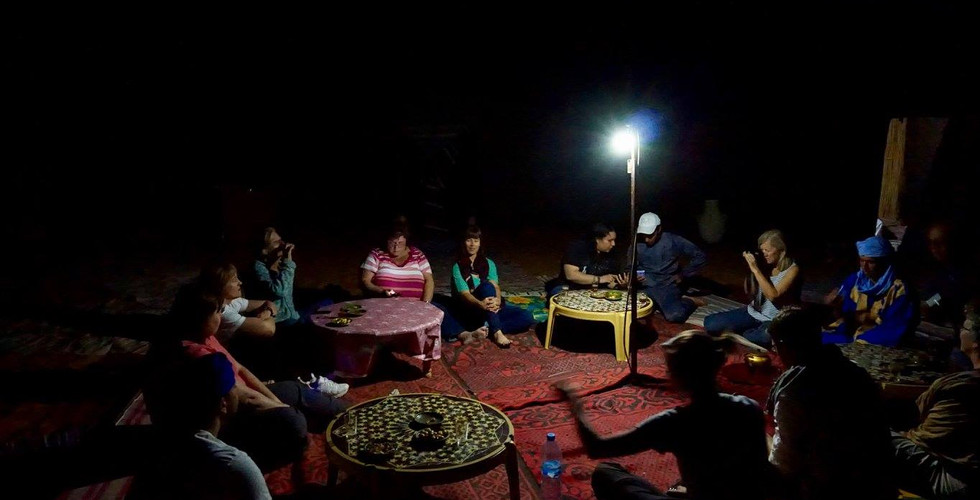5 Tips on Visiting Morocco from a Solo Female Traveler
- Katie Bernal
- Aug 17, 2017
- 7 min read

So you want to go to Morocco? Good choice! I had always had a dreamy fascination and idea of the small, northern country of Africa. It was full of bright colors, flavorful foods tied to deep traditions, and a culture so completely opposite from my own. Morocco was an alluring destination I had had on my bucket list for awhile, so to celebrate my 26th birthday, I booked a tour for my first ever international solo trip. After spending about a week and a half around the country, here are a few tips I feel are useful:
1. Morocco is Safe, Yes, even for Solo Travelers.

Now a lot of people have it in their heads that traveling to a predominately Muslim country is "unsafe," especially for a solo female traveler. However, even though I stuck with a tour group pretty much my whole trip, I felt just as safe as I did at home in Texas. As far as safety goes, it pretty much comes down to common sense. If you use common sense to guide you with smart decisions, then you should be relatively fine. It goes for any major city in the world:
Don't go out alone at night (just asking for trouble)
Respect the culture's traditions, rules and etiquette (for example: explore the country with shoulders and knees covered, it's respectful of Muslim religion and culture, as well as a way to avoid unwanted stares.)
Learn a little of the languages most commonly spoken (Locals are usually willing to help if they can, but also appreciate if you try using their language, which in Morocco happens to be French and Arabic. There are tons of free phrase books apps to help with this!)
Haggle like a local (When it comes to taxis and souvenirs, you'll most likely be charged the "tourist" price, therefor haggling shows your confidence and desire to engage in the culture.)
Be careful where you aim your camera or phone (I once took a picture of a cool doorway to a market in Casablanca and failed to see a police officer in my shot. He thought I was taking a picture of him, which is not allowed, and asked me to delete the photo. With the language barrier, it was a bit of a scary situation to have a cop chase you down. Also, a lot of people don't like cameras in their face, so be respectful and ask for permission when wanting their picture.)
2. Try Tagine, One of the Most Traditional Dishes of Morocco

There are all kinds of tagine, and honestly it's hard to avoid eating this iconic dish where ever you are in Morocco. Each region has their own version of the plate, but my favorite was the Berber Tagine. Berber refers to the older tribes of the Atlas mountains. Typically, tagine consists of vegetables (zucchini, potatoes, tomatoes, carrots), a meat (beef, chicken, lamb), and a variety of local herbs like cinnamon, saffron, ginger, cumin and paprika. Olives, which grow in many regions of Morocco are also a usual addition, as are preserved lemons. You'll also sometimes see fruit, like apples, prunes and dates added to varieties of tagine.
Tagine, also the name of the clay pot the dish is cooked in, is generally made of red clay. They say the best tagine is one that hasn't been glazed, so that each time you cook, the flavors seep within the clay and add flavor to the next time you cook. The way it works is similar to that of a dutch oven. A tagine has 2 parts: a base and cone-shaped lid with a hole at the top. As steam rises to the top of the lid, it condenses and falls back down, allowing the contents to stay moist and juicy. The top hole allows you to add water when needed.
Of course, if you're going to try tagine, you're most likely going to try it with another Moroccan staple, Moroccan mint tea. Funny enough, I learned that Moroccan mint tea was actually adopted from Britain and China. The green tea itself is imported, but Moroccans added their own twist by adding fresh mint leaves and a load of sugar cubes. You can expect, if you are served by a local, for the tea to be extremely sweet.
3. Take a Camel Ride in the Sahara Desert

This was by far my favorite part of the trip. We drove out to the edge of the desert in Merzouga, climbed onto our camels, and rode out to a campsite among the sand dunes. When we first arrived, a few of us climbed the sand dune directly behind our tents, which was no easy task. After assuming we were going to pass out and die numerous times, we finally reached the top to a rewarding view of the last hints of sunset and the moon rising. It lit up everything, and gave the usual copper sand a very milky tone. Once back down, we were served traditional food and drink and participated in some regional music with drums a few locals brought. It was a pretty magical night filled with great company and no worries.
We got up the next morning before dawn to ride out and see the sunrise. This was one of those moments you never forget, and for me, I knew it as soon as I breathed in the chilly, quite morning air and saw the first traces of pink and yellow in the sky. It was one of those moments you truly feel alive and present. Even the little grunts of our sleepy camels made that moment perfect. As touristy as it was, it was authentic Morocco to me, and I definitely recommend it.
4. Visit Small Villages in the Atlas Mountains

From traveling north to south in Morocco, we drove through the Atlas mountains. Don't get me wrong, I love a big city with all it has to offer, but the small villages have so much more authenticity when it comes to learning about a culture. I love mountain ranges, and the Atlas region was full of beautifully colored mountains and rolling hills layered with pinks, greens, blues, you name it. It was also fascinating to pass by real-life nomads. They still exist. These people live in portable small communities in the mountains and their valleys. Most of them are farmers and sheep herders. It was a step back in time realizing how different their lives were from mine, free of the drama and complexities our societies deal with today. In fact, this is something I envy Morocco of very much. We stopped in Todra Gorge and Ait Ben Haddou along the way. Even though these were pretty touristy sites, we never ran into crowds. We were able to walk around and soak in the feel of local villages. Unlike America, these people were very community oriented and tradition-driven. It was pretty quiet, and some places even had sketchy electricity. You didn't really find TVs anywhere or anyone with their eyes glued to their phones. Most people spent their time participating in religious affairs, building or crafting their goods to sell in the market and visiting with neighbors. People were always pretty friendly, but kept to themselves for the most part. It was a simple way of life I really appreciated and respected.
One thing to take advantage of while traveling to exotic places like Morocco is talk to the locals, hear their story. It was so much fun being able to discuss cultural and political differences with our tour guide, Mohammed and everyone else in the tour from other countries. We covered everything from what Moroccans thought of the Trump election, to the fact that it was a rarity to find a woman cop. I enjoyed learning about all these new friendly faces and feeling a little bit closer to the world as a whole. It's one of the best things about travel. Because you can get so drowned out in the mundane conversations at home, it was nice to be able to have deep conversations about things that really matter.
5. Buy a Moroccan Rug From a Local Cooperative.

As much as I had wished to bring home a huge Moroccan rug, they're quite a pain to take back unless you can afford to ship it home. I ended up finding a decent-sized one that I hung on my wall for a pretty good price, thanks to some tag-team haggling skills. First tip when wanting to buy a rug: don't go alone! Rug dealers can be bullies, and if you don't have a strong backbone, you'll pay a lot more than you should. It helps when you know your money is going somewhere useful too. We dropped into a women's cooperative in one of the small villages we stayed in. Because Morocco is still pretty far behind when it comes to women's rights, most Moroccan women don't have many choices when it comes to jobs or careers, especially in small communities. A lot of the women weave rugs, a family tradition handed down by generations. Typically, styles and designs differ by region, as do materials used to create these masterpieces. A lot, like the one I bought, were varied in materials like sheep hair, camel hair, and even cactus silk. The dyes are all natural, coming from items like turmeric for yellows and indigo for blues. The most intriguing part was that no rug was the same. These women would create intricate designs in their head and just start weaving. The money they earn from selling their rugs allow them to send their kids to school and put food on the table. FYI if you buy a rug at a market in a big city like Casablanca or Marrakesh, it's most likely factory made, so avoid convenience and get good quality! Plus, a lot of these women depend on it for their livelihood. If you've never haggled before, this is a great chance for practice! It took a friend speaking in Italian, pretending to be my aunt and some sad puppy eyes before we got the price of my rug down enough. Rug dealers are tough salesmen, but expect you to haggle, so don't feel bad.
Morocco is a great place to discover and explore if you're looking for something out of the ordinary. Get the most of out your experience by completely immersing yourself in the culture and getting outside your comfort zone. Places like this are a wonderful reminder of what life is really all about: living in the moment and reflecting on all the wonderful things life offers.
Feel free to reach out if you have any questions on my experiences or would like to share your own. :)











































Comments